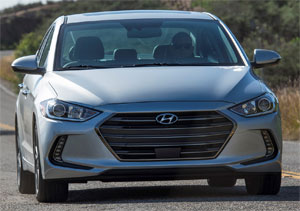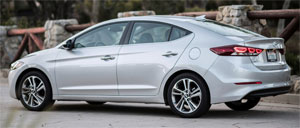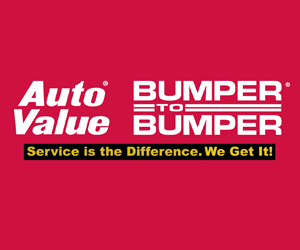2017 Hyundai Elantra
When we last left the Hyundai Elantra, its styling may have impressed us; but when it came to road manners, we thought it was more of a step back in time for this fastly progressing brand. Well, Hyundai certainly hasn’t gotten to where they are today by ending with a cliff hanger. Well, now there’s a new gen Elantra for ’17. So let’s tune in, and find out what happens next.
The Hyundai Elantra sedan has had its ups and downs since going on sale here in the early 90s. And despite our misgivings over the last generation, sales have skyrocketed of late to well over 200,000-units per year. Sounds like a lot, but that’s about 100,000 less than either the Honda Civic or Toyota Corolla. So needless to say, Hyundai is eager to boost their sales further with this 6th-generation 2017 4-door.
Styling is perhaps not as daring as last gen, but it’s still a compact looker and fully in line with larger 4-door stablemates, Sonata and Genesis. Especially up front, where it now shares their larger grille and available signature DRLs.
Same basic platform as before, but it’s had a complete onceover; with a stiffer structure, progressively more isolated suspension, and a modest increase in overall size.
 It’s 1.0-inch wider; and just shy of an inch longer, though wheelbase remains the same. 17-inch alloy wheels come with Limited trim, base SEs are equipped with 15-inch “steelies”.
It’s 1.0-inch wider; and just shy of an inch longer, though wheelbase remains the same. 17-inch alloy wheels come with Limited trim, base SEs are equipped with 15-inch “steelies”.
Most appreciably, things are a lot quieter inside, thanks to thicker glass and additional sound deadening materials.
Helping too is a new, standard 2.0-liter I4 that’s a bit more powerful than the previous gen’s 1.8-liter; at 147-horsepower and 132 lb-ft. of torque.
It’s smoother, quieter operation is readily apparent at cruising speeds. A 6-speed manual transmission is available, but only in base SE trim. A 6-speed automatic is fitted to our Limited tester.
A 128-horsepower 1.4-liter I4-powered Eco model is also available for maximum efficiency, up to 40-highway; though truth be told, the 2.0-liter is not bad in that regard either.
2.0 Government Fuel Economy Ratings are 28-City, 37-Highway, and 32-Combined. We averaged a very good 35.6 miles-per-gallon of Regular. Thus the Energy Impact Score is a good one at 10.3-barrels of oil used annually with C02 emissions of 4.7-tons.
 Front seats are plenty wide and offer above average for its class comfort. Likewise in the rear, there’s adult-size room and adequate coziness.
Front seats are plenty wide and offer above average for its class comfort. Likewise in the rear, there’s adult-size room and adequate coziness.
Trunk space is fine at 14.4 cubic-ft., but it’s cheaply finished and the deck lid feels very flimsy. However, we liked the hand-free opening smart trunk.
Limited trim delivers a display audio system with 7-inch touchscreen and Apple CarPlay and Android auto. Adding the Tech package ups it to 8-inches and adds navigation and Infinity premium audio, as well as heated seats.
Gauges are clean and simple with a 4-inch color TFT info display. The interior has definitely moved upscale in appearance, with the Ultimate package adding seat memory plus the latest in safety including blind spot detection, cross traffic alert, and even emergency braking.
Useful room is up too, so like Civic and Corolla, the Elantra is now classified as midsize by the government.
But middling is how we found full-throttle acceleration, taking 9.3-seconds to hit 60 miles-per-hour with lots of 4-cylinder wail. But, acceleration does remain steady; thanks to minimal lag between shifts. So the Elantra feels faster than the numbers; which were 17.3 in the ¼ at 83 miles-per-hour.
 Things certainly have improved in the handling department. There is plenty of grip at a moderate pace; and a playful amount of understeer when pushed harder. The car reacts quickly to steering inputs; and a nicely responsive throttle enabled us to easily keep it right on the edge, inspiring confidence as speeds increased.
Things certainly have improved in the handling department. There is plenty of grip at a moderate pace; and a playful amount of understeer when pushed harder. The car reacts quickly to steering inputs; and a nicely responsive throttle enabled us to easily keep it right on the edge, inspiring confidence as speeds increased.
Brakes were another pleasant surprise. Panic stops from 60 took a good 123–feet with minimal fade; along with a nicely firm, short travel pedal.
So with all of the improvements, the Elantra’s value proposition is also stronger than ever, as base SE pricing is actually reduced by 90-bucks to $17,985. Limited trim starts at $23,185.
Far more competent, more refined, and more consistent with Hyundai’s increasingly upscale ambitions; plus an outstanding warranty; all things that help make the 2017 Hyundai Elantra a vehicle worthy of your compact consideration. One that might finally be ready to give Corolla and Civic a real run for your money.
Specifications
- Engine: 2.0 liter I4
- Horsepower: 147
- Torque: 132 lb-ft.
- 0-60 mph: 9.3 seconds
- 1/4 mile: 17.3 seconds @ 83 mph
- EPA: 28 mpg city / 37 mpg highway
- Energy Impact: 10.3 barrels of oil/yr
- CO2 Emissions: 4.7 tons/yr
- Transmission: 6 spd auto
2025 Volkswagen ID. Buzz
Volkswagen Brings Beetlemania Level Of Excitement To Minivan Segment
The duty of upholding Volkswagen’s heritage has most recently been delegated to small legacy car names like Golf and Jetta. But hold on! A much larger, totally modern take on VW’s classic microbus has just buzzed over the horizon— the all-electric ID. Buzz. It’s been at the top of our minds since we first saw the concept back in 2017. Well, it’s finally here, so let’s get our groove into drive!
This 2025 Volkswagen ID. Buzz has indeed created the most buzz around Volkswagen since the Beetle’s return to the U.S. in the late 1990s. We couldn’t drive it anywhere without drawing a crowd. No wonder, just about everyone has a VW Microbus story to tell, and seeing this reimagined version rolling down the street brings back all those memories.
VW really pulled it off as far as we’re concerned, as it looks great without appearing over the top. All the cues are here: Big VW logo front and center, lots of greenhouse including A-pillar windows and mini sliders for the second-row passengers, D-pillar air vents, and two-tone wheels. And while its appearance may be pure retro, its drivetrain is far from it, as the ID. Buzz is all-electric, and unlike the new Beetle, the Buzz does retain the original Microbus’ rear-drive architecture.
Powering those rear wheels is a 210-kW motor drawing juice from a 91-kWh battery for a range of 234 miles; 200-kW max charging will get you to 80% in about 26 minutes. Buyers can add another small 80-kW motor up front for 4motion all-wheel-drive and an increase of total output from 282 to 335 horsepower with a combined 512 lb-ft of torque. It uses the same battery, but range estimates drop just slightly to 231 miles. But while those numbers are modest, we also found them to be quite conservative, as we observed as many as 287 miles available in our all-wheel-drive tester’s gauge display and were on pace for 273 miles in our driving loop.
One throwback theme that may be a turnoff to some is that it’s quite a step up into the Buzz’s front seats, but there’s certainly a commanding view of the road once you climb in. Second row seating can be either a three-place bench or a pair of captain’s chairs, so there’s generous room for seven or six passengers. The captain’s chairs in our Pro S Plus offer good support and very easy access to the third row.
Lots of flexibility too with the option to simply fold the seats or remove them altogether.
With the sliding side doors and a wide opening rear hatch, there’s plenty of access for loading big sport utility amounts of cargo. Lots of flexibility too with the option to simply fold the seats or remove them altogether, and the ability to create a full-length flat floor with a rear cargo shelf that covers some handy removable storage bins. There’s 18.6 cubic-feet of space behind the third row, 75.5 behind the second, and a max of 145.5. That’s more than a Chevrolet Tahoe. For smaller items, there are lots of cubbies throughout the cabin, along with a standard Buzz Box that can be moved to multiple locations.
With a design that prioritizes retro form and modern function over aero efficiency, the 4motion equipped ID. Buzz earns a Fair efficiency rating, using 42-kWh of electricity per 100 miles, and we weren’t sure what to expect at our Mason Dixon test track.
What we found was great torque off the line and drama free launches to 60 in just 5.3 seconds. It was very stable at speed and power delivery stayed steady most of the way down the track until we reached about 90 mph, when it began to taper off just before we finished the quarter-mile in 14.0 seconds flat at 97 mph.
With 1,200-lbs. of battery weight nestled in its 127.5-inch wheelbase, the Buzz felt planted to the pavement through our handling course. There was quite a bit of body roll to deal with, but surprisingly little understeer. In panic braking runs, pedal response was inconsistent, feeling soft at times, pushing back hard at others; but through it all, results were quite good, stopping from 60 in an average of just 108 feet.
Three interior themes are available, this Dune is the brightest, featuring coastal inspired wood optic dash décor, “gray and clay” leatherette surfaces, and a high-mounted central 12.9-inch touchscreen. Pricing starts with a rear-wheel-drive Pro S at $61,545; this Pro S Plus begins at $65,045, add another $4,500 for 4motion, which brings a few extra features along with all-wheel drive.
Retro design with old-school VW charm, modern EV drivetrain, big SUV capacity merged with minivan flexibility; it all comes together in this 2025 Volkswagen ID. Buzz. It’s easily one of the coolest rides of the year and one that will likely keep Volkswagen dealers buzzing for years to come, and that’s something no other people and things mover can say.
Specifications
As Tested
- Motor Setup: Dual-Motor AWD
- Battery Size: 91-kWh
- Horsepower: 335
- Torque: 512 lb-ft
- EPA Range: 231 miles
- 0-60 mph: 5.3 seconds
- 1/4 Mile: 14.0 seconds at 97 mph
- Braking, 60-0: 108 feet
- MW Test Loop: ~ 273 miles













































